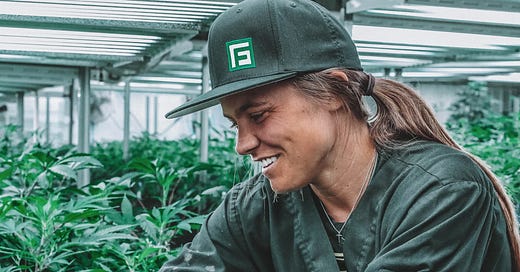This week we’re exploring the Marijuana Sector that has seen significant legalization efforts over the last decade.
Marijuana: An Overview
Marijuana is a psychoactive drug from the Cannabis plant containing Tetrahydrocannabinol (THC) and Cannabidiol (CBD). It can be smoked, vaped, infused, or used as an extract.
THC creates a sense of a “high” while CBD helps treat anxiety, seizures, and depression.
Here’s how THC varies across different parts of the Cannabis plant.
Side effects of Marijuana include euphoria, altered states of mind/time, difficulty concentrating, short term memory impairment, relaxation, and increased appetite.
When smoked, it takes effect in minutes. When cooked or eaten, it takes up to 1 hour. It’s used medically, recreationally, and sometimes spiritually.
There are 2 strains and 3 types of Marijuana.
Sativa - provides a more stimulating psychoactive
Indica - provides a more sedating feeling with a body high
Hybrid - a combination of Sativa and Indica with one strain indicated as the dominant
It is the most common illegal drug in the world except for where it’s legalized e.g. Zambia, US (some states for either medical use, recreational use, or both), Canada, and Nigeria.
Fun Fact: Hemp and Marijuana are both Cannabis plants. However, you won’t get a high from Hemp. Therefore, the law treats these differently, allowing large industrial production of hemp. Hemp is lower in THC (< 0.3%) but higher in CBD.
Medical Usage
Medical cannabis could possibly treat disease or improve symptoms, but a lot of evidence and scientific studies have been hampered by restrictions and laws around Marijuana. Once these laws are lifted, further studies can be conducted to understand Marijuana’s use cases.
Long term side effects of cannabis are not clear, but some believe there are effects on cognitive development and addiction. However, overdosing is unlikely to kill humans.
Marijuana has anxiolytic effects (reduces anxiety). There are 40 million Americans with anxiety.
There is evidence of its usage for treatment of chemotherapy induced nausea and vomiting, neuropathic pain, and multiple sclerosis.
Preparations
Farming
THC levels have been growing steadily since 1970. Growers are focused on maximizing THC levels which could help reduce tar ingestion by users. In contrast, CBD levels have declined.
In a paper published in the Biology Psychiatry Journal, in 1995, THC percent in Marijuana was around 4% while in 2014 the percent had grown to 12% thanks to innovations in agriculture such as hydroponics. In addition, the ratio of THC to CBD has dramatically increased from 10% in 2000 to about 80% in 2014. This could be due to three reasons:
consumer demand for higher THC levels is rising
more potent Marijuana can reduce operating expenses related to farming
the more potent the Marijuana, the more it can be sold for
Sizing the Market
According to DrugAbuse.gov, Marijuana is the most common psychotropic drug in the US after alcohol. In 2018, 11.8M young adults (ages 18-29, roughly) used Marijuana at least once that year. Even more surprisingly, 4% of high school seniors say they vaped THC daily.
Anne Holland Ventures, a media company focused on Marijuana, predicts a potential $1T global market cap for cannabis sales by 2027. In the US, $16B of cannabis retail sales beat 2020 expectations of $14B due to faster than expected legalizations across states.
In 2016, net profit margins of cannabis infused products (32%) for producers was at least 52% higher than other regularly consumed goods (21% or less). However, a lack of 2020 data makes it difficult to know the current margins. If this data is accurate, cannabis product sales could be more attractive as people come to realize this difference.
The chart below shows the steady growth rate of cannabis sales in the US. Medical cannabis sales have not grown as fast as recreational sales because medical Marijuana usage is already widely legalized. Given that the lower bound of their 2020 estimates is accurate, we could project that by 2023 we should see ~$25B in sales.
If the demand for Marijuana is growing, then Google Trends should also show a pattern. We looked at the prevalence of the search term, “dispensary near me”, which has never been more popular than this year. We expect such a trend to continue for the near future.
In addition, looking up the trend of the search term “anxiety” produced the following chart showing an increase over time.
The following chart exhibits the global sales of each consumer good. We believe there’s substantial opportunity for the newest contender, Marijuana, to catch up in market cap and market share to these other 2 drugs: alcohol and cigarettes (tobacco).
According to the CDC, 14% of US adults smoke cigarettes in 2019 down from 20.9% in 2005. Cigarette unit sales have declined significantly over the last 5 years. People may be shifting to vaping THC instead as a “healthier” option.
40 million Americans (~12.2%) have anxiety which could be treated with Marijuana.
Alcohol consumption per capita has remained static over the last decade showing sales are reliant on population growth, social dynamics, and inflation. Marijuana also benefits from these catalysts in addition to opportunity for increased adoption.
Marijuana could be a healthier option than smoking cigarettes in terms of tar build-up in lungs. Marijuana can be ingested without smoking or harming lungs.
Farmers are evolving Marijuana to increase their THC potency over time which helps users smoke less tar to get the same high. In comparison, cigarettes have been reducing their tar and nicotine levels but users have smoked even more units to compensate.
Marijuana has some medical uses whereas cigarettes do not.
Overdosing on Marijuana is unlikely to be fatal; overdosing on alcohol can be fatal.
Similar to how alcohol has been infused with foods like ice creams, chocolates, seltzer, sodas, pastries, and more, Marijuana also has a large market opportunity for infused cookies, butters, oils, chocolates, candies, milkshakes, ice creams, etc in addition to topical creams and ointments.
Cigarette use appears to negatively correlate with Marijuana use
Legalization
As of Nov 2020, 35 states legalized Marijuana. 15 states allow recreational usage. If we compare the map of cigarette usage with that of Marijuana legalization, then we can see a relatively negative correlation. This could imply that legalizing Marijuana may shift smokers away from tobacco and toward Marijuana.
Most recently, Governor Cuomo of NY state mentioned Marijuana should have been legalized years ago and repeated his vow to legalize it soon in response to many New Yorkers struggling from the pandemic.
Meanwhile in Congress, 68% of the senate represents states that legalized marijuana. This means that there’s a higher chance of the SAFE Act passing which means banks can no longer prohibit Marijuana businesses from using their financial services.
A few catalysts we believe are important to move legalization of Marijuana forward are listed below.
32% of arrests in 2019 were because of marijuana possession; 2.9% were for marijuana sales. Decriminalizing marijuana would reduce total arrests by 34.9%.
Blacks are 3.6x more likely to be arrested than whites for marijuana usage. However both races use marijuana at comparable rates.
62%+ of people support legalization today vs just 12% 50 year ago.
Concerns around anxiety has increased according to Google Trends which may suggest a growing demand for drugs like Marijuana
Conclusion
We believe Marijuana will be fully legalized in the US; it’s just a matter of when. There appears to be opportunity for a third recreational drug to take market share from alcohol and cigarettes, primarily because Marijuana shares many commonalities with alcohol in addition to cigarettes. Inappropriate imprisonment of Marijuana possession and ignorance of many Americans struggling day to day are big catalysts for why this problem needs to be fixed. The growing sentiment around Marijuana is that it is not excessively bad and should not be treated differently than cigarettes and alcohol. We remain optimistic about this sector and see a large opportunity for growth.
References:
"CBD vs. THC: Properties, Benefits, and Side Effects - Healthline." https://www.healthline.com/health/cbd-vs-thc. Accessed 19 Jan. 2021.
"Increasing Delta-9-Tetrahydrocannabinol (A-9-THC) - DATIA.org." https://www.datia.org/datia/resources/IncreasingDelta9.pdf. Accessed 18 Jan. 2021.
"Changes in Cannabis Potency over the ...." 19 Jan. 2016, https://www.ncbi.nlm.nih.gov/pmc/articles/PMC4987131/. Accessed 20 Jan. 2021.
"Marijuana DrugFacts - National Institute on ...." 24 Dec. 2019, https://www.drugabuse.gov/publications/drugfacts/marijuana. Accessed 19 Jan. 2021.
"Size Matters: The Total Addressable Market of Cannabis ...." https://www.lidoconsulting.com/size-matters-the-total-addressable-market-of-cannabis-hemp-is-far-bigger-than-analyst-predictions/. Accessed 19 Jan. 2021.
"Chart of the Week: Profit Margins for Infused Products Can Be ...." 21 Mar. 2016, https://mjbizdaily.com/chart-week-profit-margins-infused-products-can-sky-high/. Accessed 18 Jan. 2021.
"Exclusive: US retail marijuana sales on pace to rise 35% in ...." 30 May. 2019, https://mjbizdaily.com/exclusive-us-retail-marijuana-sales-on-pace-to-rise-35-in-2019-and-near-30-billion-by-2023/. Accessed 19 Jan. 2021.
"FTC Tar, Nicotine & Carbon Monoxide Report - 1998 - Federal ...." https://www.ftc.gov/sites/default/files/documents/reports/2000-report-tar-nicotine-and-carbon-monoxide-covering-1998/1998tarnicotinereport_0.pdf. Accessed 20 Jan. 2021.
"FTC Cigarette Report for 2018 - Federal Trade Commission." https://www.ftc.gov/system/files/documents/reports/federal-trade-commission-cigarette-report-2018-smokeless-tobacco-report-2018/p114508cigarettereport2018.pdf. Accessed 19 Jan. 2021.
"The Future of the Marijuana Industry in America - Investopedia." 12 Nov. 2020, https://www.investopedia.com/articles/investing/111015/future-marijuana-industry-america.asp. Accessed 21 Jan. 2021.
"Legalized Marijuana in New York: This Could Be the Year ...." 6 Jan. 2021, https://www.nytimes.com/2021/01/06/nyregion/marijuana-new-york-cuomo.html. Accessed 20 Jan. 2021.
"S.1152 - 115th Congress (2017-2018): SAFE Banking Act ...." https://www.congress.gov/bill/115th-congress/senate-bill/1152. Accessed 20 Jan. 2021.
"FBI — Persons Arrested - Uniform Crime Reporting (UCR ...." https://ucr.fbi.gov/crime-in-the-u.s/2019/crime-in-the-u.s.-2019/topic-pages/persons-arrested. Accessed 19 Jan. 2021.
"Trends in anxiety among adults in the United ... - NCBI - NIH." 21 Aug. 2020, https://www.ncbi.nlm.nih.gov/pmc/articles/PMC7441973/. Accessed 19 Jan. 2021.
This letter may not be reproduced in whole or in part without the express consent of Drawing Capital Group, LLC (“Drawing Capital”).
This letter is not an offer to sell securities of any investment fund or a solicitation of offers to buy any such securities. An investment in any strategy, including the strategy described herein, involves a high degree of risk. Past performance of these strategies is not necessarily indicative of future results. There is the possibility of loss and all investment involves risk including the loss of principal.
The information in this letter was prepared by Drawing Capital and is believed by the Drawing Capital to be reliable and has been obtained from sources believed to be reliable. Drawing Capital makes no representation as to the accuracy or completeness of such information. Opinions, estimates and projections in this letter constitute the current judgment of Drawing Capital and are subject to change without notice.
Any projections, forecasts and estimates contained in this document are necessarily speculative in nature and are based upon certain assumptions. In addition, matters they describe are subject to known (and unknown) risks, uncertainties and other unpredictable factors, many of which are beyond Drawing Capital’s control. No representations or warranties are made as to the accuracy of such forward-looking statements. It can be expected that some or all of such forward-looking assumptions will not materialize or will vary significantly from actual results. Drawing Capital has no obligation to update, modify or amend this letter or to otherwise notify a reader thereof in the event that any matter stated herein, or any opinion, projection, forecast or estimate set forth herein, changes or subsequently becomes inaccurate.



















